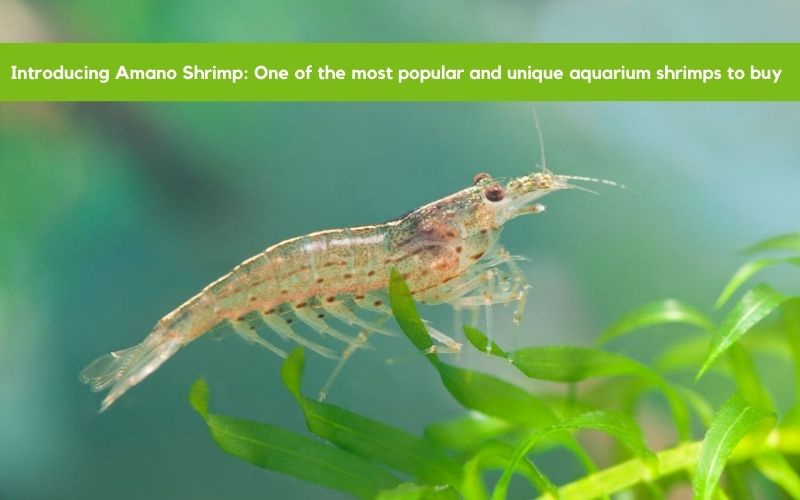
Introducing Amano Shrimp: One of the most popular and unique aquarium shrimps to buy
The distinctiveness of Amano Shrimp
Amano shrimp, which is native to Japan and the majority of Korea, China, and Taiwan and is a member of the Atyidae family, goes by a variety of vernacular names. When Takashi Amano, a late aquarist, found that these freshwater shrimp could consume huge amounts of algae, he began to popularise them.
The Amano shrimp (Caridina multidentata), which feeds on nearly every variety of algae in the freshwater tank and even consumes the red algae and black beard algae that are typically rejected by other organisms, is renowned for reducing algae buildup. They play a crucial function as an efficient cleanser in a tank's ecosystem because they consume everything, even litter, and keep tanks clean. The ability to consume unusually huge numbers of algal bodies and other materials makes them a well-known aggressive feeder. Amano shrimps are very calm creatures, which makes them a wonderful addition to communal aquariums. Despite being calm creatures, they have a darker side and are quite self-centred when it comes to food. As scavengers, they are incessantly cleaning surfaces while searching for food. Due to their omnivorous nature, these shrimp can eat nearly anything in the natural world. The Amano shrimp is among the species that are most active in the ecosystems of freshwater aquariums. Additionally, when they sense danger, they can blend into their environment, allowing them to stay vigilant and protected.
WHY AMANO SHRIMP IS THE BEST CREATURE FOR BEGINNERS IN AQUARIUM KEEPING?
Weirdly savoury palate of Amano Shrimps
Amano shrimps are omnivorous despite being primarily regarded as algae-eating shrimp. They benefit from a balanced diet for maximum longevity and survival. They are ravenous eaters and will devour practically any soft algae, except for cyanobacteria and blue-green algae. They scour the aquarium's bottom incessantly for food, foraging and scavenging for soft algal bodies such as:
Hair algae:
One of the most common algae that flourish and grow in a tank is hair algae. They have a bright green colour and appear to be made of long strings of hair or string. They tend to cling to any tank surface and grow remarkably quickly. However, compared to other algae, the algae's attachment to any surface is weak, making it the perfect diet for Amano shrimps to eat.
Green Spot algae:
These are the types of algae that typically show tiny, circular green spots that attach to the aquarium tank's glass, plants, rocks, and substrates. In hard water, they stay small and develop quickly; the harsher the water, the more adamant they are.
One of the aquatic species that can eat green spot algae is the amano shrimp, however, because these algae like to stick to glass, it may be challenging for them to digest the spots completely.
Red algae: These are not technically called plants, although they share cell walls with plants and use chlorophyll for photosynthesis. They have a reddish, purplish, purple, or reddish-purple appearance and are made up of microscopic organisms that can be single-celled or multicellular. Quite a few aquatic animals can consume these algae and survive but due to their ability to filter-feed, Amano shrimp is one of the few freshwater shrimp that consume red algae.
Apart from algae, their appetite includes:
Dead plant matters: As additional nutrients, they consume stems from dead or decaying plants, which would normally collect at the surface's bottom.
Fish and other animal waste:
Amano shrimp examine the faeces of other fish and creatures for any little fragments of undigested food or nutrient content that they might include in their diet.
Other fish and shrimp:
Amanos also enjoy the taste of other fish and shrimp, as well as worms and snails. After the moulting stage, they also eat their exoskeleton to get extra calcium and other nutrients. They might also eat shrimp that are young or delicate from other species, such as cherry shrimp or sakura red shrimp.
They don't let anything the natural world provides them with go to waste because of their proactive commitment to constantly be active and continuously eat. By cycling nutrients and regulating nutrient outflows from ecosystems, amano shrimps, like all other shrimps, support ecosystems. Amano Shrimp are the ideal addition for aquarium hobbyists who frequently forget to clean their tanks.
Disclaimer: The opinions expressed in this article are those of the author's. They do not purport to reflect the opinions or views of The Critical Script or its editor.

Newsletter!!!
Subscribe to our weekly Newsletter and stay tuned.

















Related Comments